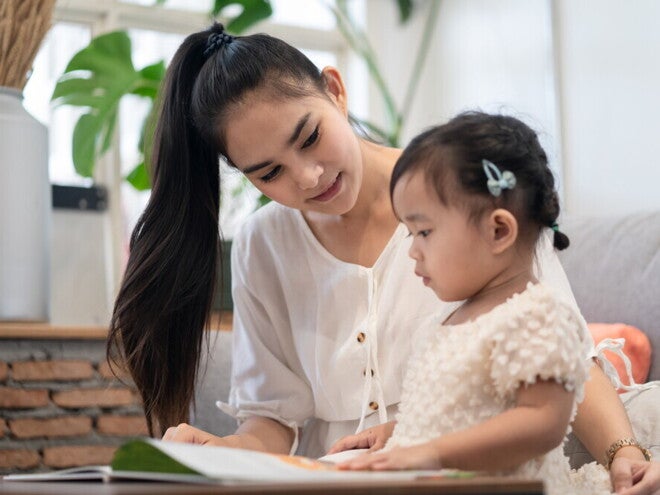
12 Filipino Children’s Books That Help You Teach the Big Lessons
Your child comes home from school, sad because a classmate wouldn't share a toy. You want to explain fairness and kindness, but where do you begin? You can start with a story. The right Filipino children's books turn these meaningful moments into valuable lessons in empathy, supporting your child's development.
In fact, a 2025 study in Frontiers in Psychology found that reading books about social topics, such as sharing and helping, actually makes children kinder. The stories help develop a child's ability to understand others' feelings, which in turn leads them to be more helpful and caring.
Check out the list of books below, which includes books for toddlers, preschoolers, and older children to find the perfect story for every stage.
1. Hati Tayo!
By Russell Molina, illustrated by Dominic Agsaway
Lesson: The joy and importance of sharing
This charming board book shows a simple, relatable problem for little ones: when two people want the same thing. Through sweet illustrations, Hati Tayo! helps you gently introduce the concept of sharing and fairness to your toddler.
Perfect for: Ages 0 to 3
2. Mga Pasahero sa Dyip
By Gina Unson-Rivera, illustrated by Domz Agsaway
Lesson: Appreciation for community and Filipino culture
Mga Pasahero sa Dyip takes your child on a jeepney ride and introduces them to the different kinds of people they can meet on a single trip. This slice-of-life story is a wonderful way to foster your child’s observation skills and appreciation for community.
Perfect for: Ages 0 to 3
3. Bee Brave
By Joyce Piap-Go, illustrated by Maria Cristina Sison
Lesson: Understanding fear and choosing to be brave
This book, from the popular “Dee the Bee” series, teaches your preschooler that it’s okay to feel scared. But bravery allows them to have fun and try new things.
Perfect for: Ages 2 to 5
4. Ang Mabait na Kalabaw
By Virgilio S. Almario, illustrated by Liza Flores
Lesson: Being a good role model and basic counting
Through his good deeds and positive attitude, the carabao can help you show your child the importance of truth, compassion, and getting along with others.
Plus, each page integrates a counting element from 1 to 13, developing early math skills along with character-building in your child.
Perfect for: Ages 2 to 5
5. Hipon and Biya
By Carla M. Pacis, illustrated by Joanne de Leon
Lesson: Friendship, teamwork, and celebrating differences
This story helps you teach your child about the power of teamwork. Through the unlikely friendship of a shrimp and a goby fish, it shows how two very different friends can use their unique traits to become stronger together.
Perfect for: Ages 3 to 7
6. Araw sa Palengke
By May Tobias-Papa, illustrated by Isabel Roxas

Lesson: Gratitude and appreciation for simple joys
This award-winning story follows a young child’s exciting trip to the market with their mother, capturing the vibrant sights and sounds of a bustling palengke. The story can help your child realize that love isn’t just about toys or treats—it’s found in shared moments and small acts of care.
Perfect for: Ages 4 to 7
7. When Lola Visits
By Michelle Sterling, illustrated by Aaron Asis
Lesson: Cherishing family traditions and long-distance love
If your family lives abroad, you'll see your own experience in this heartwarming story about a summer visit from a beloved lola from the Philippines. It demonstrates how family bonds are strengthened by shared traditions, from the scent of mango jam to the sound of Tagalog songs.
You can use this book to talk about cherishing every moment you have with loved ones who live far away.
Perfect for: Ages 4 to 8
8. Si Emang Engkantada at ang Tatlong Haragan
By Rene O. Villanueva, illustrated by Alfonso Oñate and Wilfredo Pollarco
Lesson: Environmental responsibility and respect for nature
This classic story follows three mischievous children who waste water, destroy plants, and litter without a second thought. Through a memorable lesson from the enchantress, Emang Engkantada, your preschooler will learn about the direct consequences of their actions.
Perfect for: Ages 4 to 8
9. Papa’s House, Mama's House
By Jeanette Patindol, illustrated by Mark Ramsel N. Salvatus III
Lesson: Navigating family separation with love and reassurance
Papa’s House, Mama's House helps parents to start conversations and validate your child’s feelings in a co-parenting setup.
Told from the voice of a child, Jeanette Patindol’s story describes the experience of living in two separate homes—one with Mama and one with Papa. It reassures children that even though their parents live apart, the love they receive is whole, constant, and unchanging.
Perfect for: Ages 4 to 8
10. Ang Ikaklit sa Aming Hardin
By Bernadette Villanueva Neri, illustrated by CJ de Silva
Lesson: Family diversity and acceptance
If you want to talk about different kinds of families, this groundbreaking story is the perfect place to start. It helps you introduce the concept of a loving family with two mothers, using the beautiful symbol of a garden as their nurturing home. It’s a warm and affirming story about love and family.
Perfect for: Ages 5 to 8
11. Isang Harding Papel
By Augie Rivera, illustrated by Rommel Joson
Lesson: Hope, resilience, and love in the face of separation
Set during the difficult period of martial law, this poignant story follows a young girl named Jenny, who has been separated from her mother. While waiting for her mom to come home, Jenny creates a garden of paper flowers—a touching symbol of her enduring love and hope.
It’s a powerful yet gentle way to introduce your child to a difficult period in Philippine history, focusing on the strength of family bonds amidst injustice.
Perfect for: Ages 8 to 12
12. The Magic Arrow
By Bonet Banal, illustrated by Korinne Banal
Lesson: The importance of freedom of expression and courage
At first, you might think this is just a fairytale about a king who forbids colorful books and laughter. But as you read, you’ll discover it’s a powerful allegory for an important chapter in Philippine history, inspired by the sacrifice of Ninoy Aquino. You can use this story to discuss oppression, courage, and the importance of protecting personal freedoms with your older child.
Perfect for: Ages 8 to 12
How to Use These Books to Teach Life Lessons

The story is just the start. Here’s how to relate the lessons to your child.
- Ask questions after reading, like, “What would you have done in that story?”
- Connect the story’s message to a real family experience or something they see every day.
- Live the lesson by pointing out examples of the value (like bravery or compassion) in your own everyday actions.
These educational books use valuable moral stories and relatable characters to spark important conversations that help your child’s development. By choosing Filipino children's books, you also connect your child to their own culture.
Ultimately, these stories can help your child discuss their feelings, develop character, and learn life skills. The best part? You can find many of these children's books at your favorite local and online bookstores.
What's your family's favorite children’s book? Share your recommendations with other parents in the ParentTeam Moms and Dads Facebook group.









